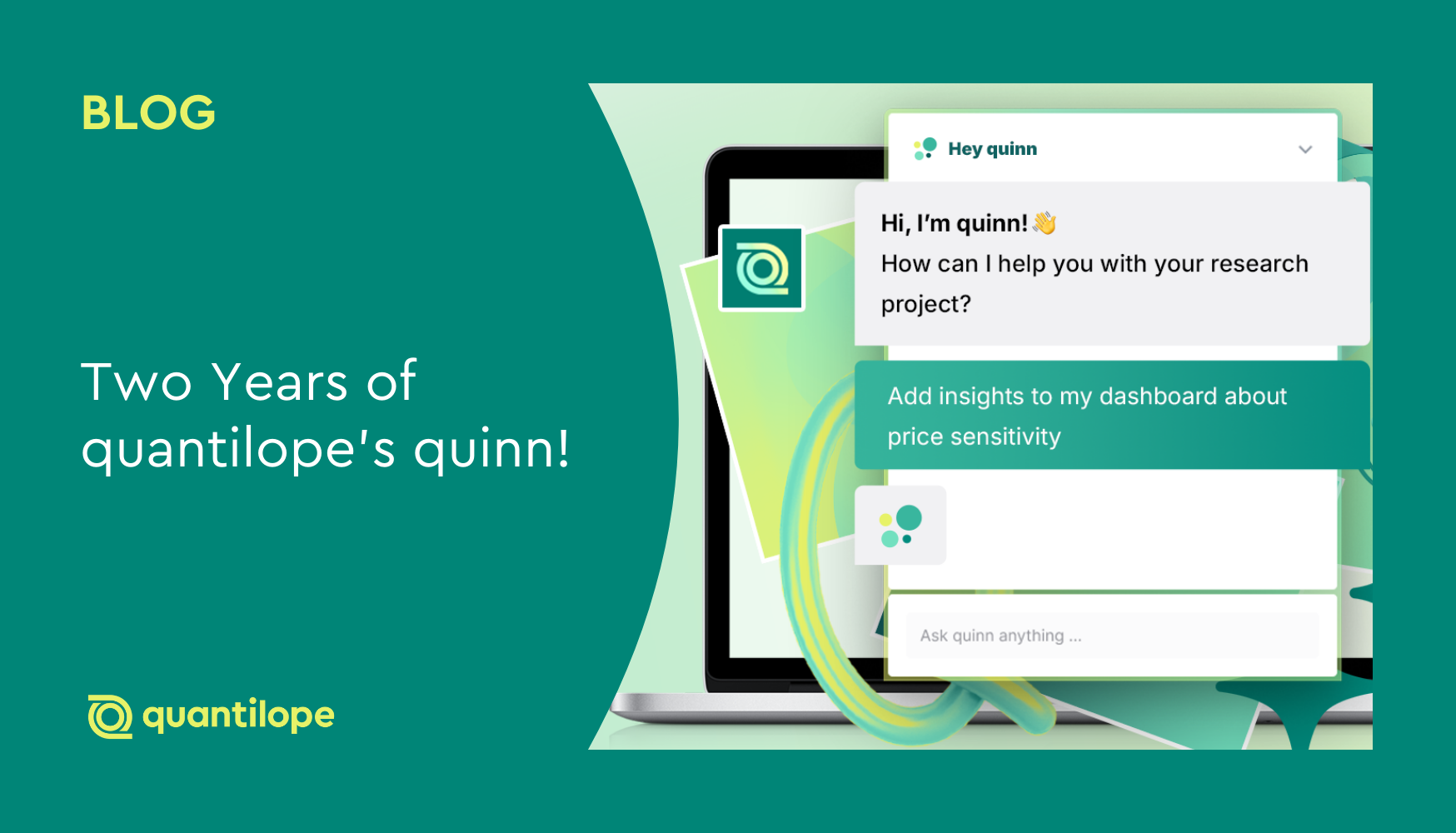To stay competitive in today's dynamic and competitive business landscape, having advanced method data to support business decisions and keep up with consumer trends will be what separates leading businesses from those racing to catch up.
From established enterprises to scrappy startups and growing small businesses, insights professionals from all different sectors of research are supplementing or replacing their usage and attitude insights with robust market research methods to gain a deep understanding of their target market, market trends, and competitive analysis.
Table of Contents:
Understanding market research methods
Before exploring advanced method techniques, businesses need to understand the foundation and fundamentals of market research.
What are advanced market research methods?
Advanced market research methods are types of survey questions that allow brands to gain rich, valuable insights about potential customers, competitors, and their overall market environment. Businesses can use advanced market research methods to gather data for a variety of research objectives. For example, brands might opt for advanced method research to inform their marketing strategy and optimize marketing campaigns; to segment their target audience to curate offerings; or to gather pricing data to remain lucrative and competitive.
Advanced methods use complex behavioral science techniques and calculations that capture detailed insights from survey respondents. Some advanced methods even capture underlying associations through speed of reaction time (implicit testing), forced tradeoffs (MaxDiff), and associated behavior drivers (Key Driver Analysis).
Because of the depth and complexity of advanced method insights, brands can answer questions about their business with more detail and actionability than traditional usage and attitude metrics alone; this is true even for brands that aren't familiar with the intricacies of advanced methods' complex calculations – as most advanced methods are fully automated on research platforms or handled by expert behavioral science teams.
Primary vs. secondary research methods
When it comes to collecting data, brands have a choice between primary market research and secondary market research.
- Primary market research involves collecting firsthand data, specifically tailored to your research objectives. This often involves direct interaction with consumers through methods like online surveys and questionnaires, in-depth interviews, focus groups, and observations (in real-world settings or online). This type of research is crucial for gaining current, specific insights into your target audience that you wouldn’t be able to find anywhere else. Given its uniqueness, primary research is often more expensive and time-consuming than secondary research.
- Secondary market research involves gathering pre-existing data (i.e. data that’s been previously collected by your organization or external sources for purposes other than your specific research needs). Secondary market research can include public research reports, industry trends, government publications, competitor analyses, and existing internal company data. While often more cost-effective and quicker to access, secondary research data may not always perfectly align with your specific research needs or fully answer your research questions.
Advanced method data will most likely require a primary research approach, as advanced methods are highly specific to a research objective and target audience. However, it’s possible that advanced method data already exists and still gets you close to answering your research question(s) – such as your organization's existing segmentation study that highlights niche audience groups. You can use these existing insights as a foundation. For brands with limited time or budget, it could be worthwhile to explore secondary data as a starting point, and follow up with more specific primary research studies.
Qualitative vs. quantitative research methods
Another crucial distinction in research methods is the difference between qualitative research and quantitative research.
- Quantitative research is based around numerical data and statistical analysis to measure and quantify opinions, attitudes, and behaviors. It aims to answer questions around "how many" or "how much", and typically involves relatively large sample sizes. Most quantitative research today is done through online questionnaires that involve open and closed-ended questions. Modern online survey platforms offer sophisticated features like skip logic, randomization, and multimedia integration. Many even offer pre-built survey templates that further streamline the research process. Given their online nature and the ease of mass circulation, quantitative studies can be sent to specific demographics anywhere in the world to quickly capture responses among respondents that represent the makeup of a brand’s true or ideal target audience.
- Qualitative research focuses on exploring in-depth consumer behaviors, opinions, and motivations. It seeks to answer "why" questions and often involves relatively smaller sample sizes. Common qualitative research methods include in-depth interviews, focus groups (which can be conducted in-person or online), and open-ended questions in questionnaires. This type of research helps uncover underlying consumer behavior and consumer preferences by exploring topics in a less structured format than quantitative questionnaires.
Most advanced method research falls under the quantitative category, capturing rich quantifiable metrics to base decisions off of. However, it’s a strategic approach to complement quantitative insights with qualitative feedback from interviews or focus groups to explore certain findings in more depth.
Back to Table of Contents
Market research methods that match your business needs
There are many types of advanced research methods (quantilope has 15 methods to choose from!), each depending on your specific goals and needs. Below are a few commonly-leveraged methods that help businesses get closer to the ‘why’ and 'how' behind consumer behavior.
A/B Testing
A/B testing, also known as split testing, is a powerful method for comparing two or more versions of an asset (e.g., website landing pages, email campaigns, marketing advertisements, packaging prototypes, product concepts, etc.) to determine which performs better in the market. By randomly showing different versions of an asset to segments or sub-samples of your audience and tracking their responses, you can make data-driven decisions to optimize your marketing strategy effectiveness.
Conjoint analysis
Conjoint analysis is a sophisticated method used to understand how consumers value different attributes or features of a product or service. By presenting respondents with various hypothetical product profiles, each with varying attribute levels, you can determine the relative importance of each specific attribute to predict consumer preferences for new product configurations. Commonly tested attributes include package sizes, pricing levels, and scents or flavors. This particular advanced method is great for new product development research.
MaxDiff analysis
Maximum Difference (MaxDiff) analysis is a preference-scaling technique that helps identify the most and least preferred items from a set of options. A MaxDiff presents respondents with varying sets of items and forces them to make tradeoff decisions between the most and least appealing in each set. This method is particularly useful for understanding feature preferences, brand appeal, and message effectiveness. It mitigates the ‘everything is important’ bias often seen in traditional usage and attitude questions.
Implicit Association Testing (IAT)
Implicit Association Testing (IAT) is a method used to uncover subconscious attitudes and associations that consumers may not even be aware they have (or willing to explicitly state). It bridges the gap between what consumers say and what they do. By measuring response times to pairings of concepts and attributes, implicit testing can reveal hidden biases and preferences that influence buying habits and consumer behaviors. Brands can test associations for a single product, brand, or category with a Single Implicit Association Test (SIAT), or they can test associations for multiple products, brands, and categories with a Multi-Implicit Association Test (MIAT).
Key Driver Analysis
Key Driver Analysis is an advanced method used to identify the most important factors (drivers) that influence (or, drive) a specific outcome variable, such as customer satisfaction, purchase intent, or brand loyalty. By analyzing the relationship between various potential drivers and the outcome variable, businesses can focus their efforts on the factors that have the greatest impact rather than spreading their resources thin across business initiatives that don’t generate results.
Back to Table of Contents
Choosing the right market research methods
Selecting the appropriate market research method is crucial for obtaining meaningful, actionable, and valuable insights. Brands should consider several factors during this decision-making process to choose the right method for their goals.
Matching methods to business objectives
The first step in choosing a market research method is to clearly define your research objectives. What specific answer questions are you trying to address with your insights? What decisions are you hoping the research will inform – such as new product development or marketing strategy? Certain research methods are better suited than others depending on the objective. For example, if you want to understand customer perceptions of a new product concept, qualitative research methods like focus groups or in-depth interviews might be a good exploratory research starting point. But if you want to quantify the potential market size for that product, a larger-scale quantitative research survey would be more useful and actionable.
Building a comprehensive research strategy
Sometimes the most effective customer research approaches involve a combination of different methodologies. Combining qualitative research and quantitative research can provide a richer and more nuanced understanding of the market, while using multiple quantitative research methods together in one study can add to the breadth of your insights. For instance, you might start with qualitative research to explore consumer attitudes toward a new product and then follow up with a quantitative study that includes a MaxDiff of product features and a TURF analysis to determine which channels you’ll eventually use to market it.
Emerging trends in market research method adoption
Market research techniques are constantly evolving, driven by technological advancements and changing consumer behaviors. This makes it even more exciting to choose a method that fits your specific needs.
When choosing a method, consider the following:
- Automation: Can you leverage automation and AI-powered platforms to gather advanced method survey insights and generate automated data analysis visualizations? Automation makes advanced method research faster and more efficient than more traditional, agency-led approaches.
- Data integrations: Many research platforms today let you integrate other tools for vast amounts of data from various sources such as social media, social listening tools, CRM systems, and other consumer behavior applications. Using this type of data alongside your advanced method insights will add an even greater level of detail to your overall consumer story.
- Mobile-first research: With the unavoidable prevalence of mobile devices, it’s important to design research studies that are optimized for mobile to ensure high participation from your target customers. When choosing your advanced method, double check that it can be set up and scaled for mobile devices without compromising user experience.
Back to Table of Contents
Implementing advanced research methods with quantilope
Implementing advanced market research methods can seem daunting, especially for organizations with limited in-house expertise. Automated platforms like quantilope offer an intuitive and agile way to capture advanced method insights, even for more complex methodologies (like Segmentation and Conjoint analysis).
Users of all skillsets or from any market research background can drag and drop methods into quantilope’s survey editor, creating as simple or as detailed of a survey as they wish. From simple questionnaires about a marketing campaign to advanced studies incorporating an A/B test or Key Driver analysis, quantilope empowers all insights leaders to conduct market research, quickly gather data, and extract actionable, valuable insights in real-time.
For those looking for more support, quantilope’s team of research consultants are always available to answer any questions and guide your study along, while quantilope’s integrated AI co-pilot, quinn, offers another layer of support as an always-on chat assistant to answer specific user-generated research prompts or requests (i.e., ‘Which advanced methods should I add to my study?’). Think of quinn as your collaborative research partner, ready to inspire and guide you throughout every stage of your research process.
Frequently asked questions:
How do automated research methods compare to traditional approaches in terms of cost and time efficiency?
Automated research methods often offer significant advantages in terms of both cost, time, and efficiency – as compared to traditional research approaches. By streamlining processes like survey programming, data collection, and data analysis for advanced method projects, automation reduces the need for extensive manual effort while accelerating project timelines. This can lead to lower overall research costs and faster access to critical insights.
Which market research methods are best for obtaining actionable insights when faced with rapidly changing consumer preferences?
In rapidly changing environments, agile and adaptive research methods are crucial. A/B testing allows brands to quickly evaluate different marketing campaigns before bringing a final one to market.For brands looking to quickly prioritize key features of their product offering or marketing campaign, MaxDiff studies allow brands to quickly captured consumers’ forced tradeoff decisions.And for brands looking to navigate a changing economic environment due to inflation or tariffs, a Price Sensitivity Meter is a great method to capture price sensitivities.
These are just a few ways to leverage advanced methods for rapidly changing preferences. To help navigate which advanced methods are best for your needs, we've created a list of all of quantilope's advanced methods and how to use them.
How can companies with limited in-house research expertise successfully implement advanced research methodologies?
Companies with limited in-house research expertise can successfully implement advanced methodologies by leveraging user-friendly, automated platforms like quantilope.
Automated platforms provide intuitive interfaces, guided workflows, built-in guardrails, and automated analysis, democratizing access to sophisticated research techniques. Many of these platforms even offer AI co-pilot assistants, like quantilope’s quinn, which become a true extension of a research team.
What is the typical learning curve for non-researchers to understand and use advanced research methods through an automated platform?
The learning curve for non-researchers using automated platforms is typically significantly shorter compared to mastering traditional statistical software or manual research processes with agencies.
These platforms are designed with user-friendliness in mind, often featuring drag-and-drop interfaces, clear explanations, and readily available support resources. While understanding the underlying hypotheses and principles of each method is beneficial, the platform handles much of the technical complexity involved with using advanced methods.
How can I demonstrate the ROI of investing in advanced market research methods to my stakeholders?
To effectively demonstrate the ROI of advanced market research, try your best to quantify the benefits it brings to your organization.
Quantifiable metrics can include:
- Improved marketing effectiveness: Higher conversion rates from optimized marketing campaigns informed by A/B testing.
- Successful product development and launches: Increased adoption rates for new products designed based on Conjoint analysis insights.
- Reduced risk of costly mistakes: Avoiding investments in initiatives that are unlikely to resonate with your target market or make a significant impact on the business, as identified through research tactics like MaxDiff or TURF.
- Enhanced customer satisfaction and loyalty: Increased retention rates resulting from a deeper understanding of customer needs and preferences using a MaxDiff or Need-Based Segmentation. Or, directly measure word-of-mouth recommendations with a Net Promoter Score (NPS).
By tracking key metrics and attributing positive outcomes to research-driven decision-making, you can effectively demonstrate to stakeholders the value of investing in advanced market research methods.





.png)